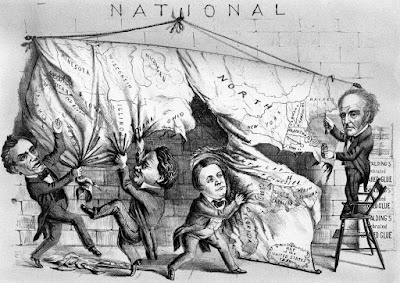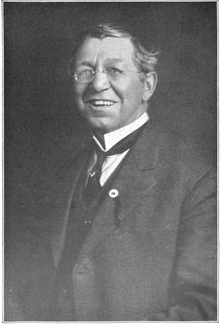March 20, 1854: Republican Party is formed
At the nation's founding, the issue of faction and political party was becoming a growing problem. The Founders were deeply worried that faction would divide the young country. Their worries proved to be a reality. By 1800, two parties had formed, the Federalists and the Democratic-Republicans, to compete for control of the government. The Federalists, founded by Alexander Hamilton, advocated for a larger federal government, an economy based on industrialization, and was mostly made up of urban easterners. The Democratic-Republicans, founded by Thomas Jefferson, advocated for a smaller government, an economy based on agriculture, and was mostly made up of southerners, and westerners. The two parties would compete until the collapse of the Federalist Party in wake of the War of 1812. The Democratic-Republican Party would further split into different factions until the Presidency of Andrew Jackson. The contested Election of 1828 would start the next phase in the party system of the United States.
 When Jackson won the Election of 1828, he would heralded in a new political party into power, the Democratic Party. The Democrats were formed from several factions of the Democratic-Republicans. The new party, founded by Martin Van Buren, advocated for similar ideals to the Democratic-Republicans, with one major exception. They favored an expansion of voting rights to all white men who held a certain amount of property (the property stipulation soon dropped off). The Democrats, a large portion of which were slaveholders, believed in the greater expansion of slavery. However, the Democrats positive view of slavery would not sit well with every American. The Whig Party would be formed in opposition to the Democrats. They formed from a coalition of former Federalists who favored Jackson's rival, John Quincy Adams. Founded by Henry Clay and Daniel Webster, the Whigs held similar ideals to the Federalists, but also with a firm belief in the reduction of slavery. However, these two parties still did not appeal to everyone. Throughout the 1840's and 1850's, several parties would form based on various political believes of the day. There was an Anti-Masonic Party, a Nativist Party, and many others created to meet the ideological needs of their constituents. Out of this political chaos, another party would form to rival the two dominant parties.
When Jackson won the Election of 1828, he would heralded in a new political party into power, the Democratic Party. The Democrats were formed from several factions of the Democratic-Republicans. The new party, founded by Martin Van Buren, advocated for similar ideals to the Democratic-Republicans, with one major exception. They favored an expansion of voting rights to all white men who held a certain amount of property (the property stipulation soon dropped off). The Democrats, a large portion of which were slaveholders, believed in the greater expansion of slavery. However, the Democrats positive view of slavery would not sit well with every American. The Whig Party would be formed in opposition to the Democrats. They formed from a coalition of former Federalists who favored Jackson's rival, John Quincy Adams. Founded by Henry Clay and Daniel Webster, the Whigs held similar ideals to the Federalists, but also with a firm belief in the reduction of slavery. However, these two parties still did not appeal to everyone. Throughout the 1840's and 1850's, several parties would form based on various political believes of the day. There was an Anti-Masonic Party, a Nativist Party, and many others created to meet the ideological needs of their constituents. Out of this political chaos, another party would form to rival the two dominant parties.
 In 1854, Congress passed the Kansas-Nebraska Act, which created the territories of Kansas and Nebraska with an allowance for slavery's expansion into them. Up to this point, the Whigs had been the anti-slavery party, but they were powerless to stop this legislation. Many of the party's members were fed up with their party's inabilities. On March 20, they met in Ripon, Wisconsin to oppose the new law. These discouraged Whigs separated and formed a new party, the Republican Party, so named to emphasize their anti-slavery stance. In 1856, they held their first national convention, nominating John C. Fremont to head the presidential ticket. Fremont would lose to his Democratic opponent, James Buchanan, but this would not stop the Republicans' growth. In 1860, a little known Illinois politician rose through the ranks of the party to be nominated to head the ticket in that year's election. His name was Abraham Lincoln and his election as the first Republican President would forever change American history.
In 1854, Congress passed the Kansas-Nebraska Act, which created the territories of Kansas and Nebraska with an allowance for slavery's expansion into them. Up to this point, the Whigs had been the anti-slavery party, but they were powerless to stop this legislation. Many of the party's members were fed up with their party's inabilities. On March 20, they met in Ripon, Wisconsin to oppose the new law. These discouraged Whigs separated and formed a new party, the Republican Party, so named to emphasize their anti-slavery stance. In 1856, they held their first national convention, nominating John C. Fremont to head the presidential ticket. Fremont would lose to his Democratic opponent, James Buchanan, but this would not stop the Republicans' growth. In 1860, a little known Illinois politician rose through the ranks of the party to be nominated to head the ticket in that year's election. His name was Abraham Lincoln and his election as the first Republican President would forever change American history.
 When Jackson won the Election of 1828, he would heralded in a new political party into power, the Democratic Party. The Democrats were formed from several factions of the Democratic-Republicans. The new party, founded by Martin Van Buren, advocated for similar ideals to the Democratic-Republicans, with one major exception. They favored an expansion of voting rights to all white men who held a certain amount of property (the property stipulation soon dropped off). The Democrats, a large portion of which were slaveholders, believed in the greater expansion of slavery. However, the Democrats positive view of slavery would not sit well with every American. The Whig Party would be formed in opposition to the Democrats. They formed from a coalition of former Federalists who favored Jackson's rival, John Quincy Adams. Founded by Henry Clay and Daniel Webster, the Whigs held similar ideals to the Federalists, but also with a firm belief in the reduction of slavery. However, these two parties still did not appeal to everyone. Throughout the 1840's and 1850's, several parties would form based on various political believes of the day. There was an Anti-Masonic Party, a Nativist Party, and many others created to meet the ideological needs of their constituents. Out of this political chaos, another party would form to rival the two dominant parties.
When Jackson won the Election of 1828, he would heralded in a new political party into power, the Democratic Party. The Democrats were formed from several factions of the Democratic-Republicans. The new party, founded by Martin Van Buren, advocated for similar ideals to the Democratic-Republicans, with one major exception. They favored an expansion of voting rights to all white men who held a certain amount of property (the property stipulation soon dropped off). The Democrats, a large portion of which were slaveholders, believed in the greater expansion of slavery. However, the Democrats positive view of slavery would not sit well with every American. The Whig Party would be formed in opposition to the Democrats. They formed from a coalition of former Federalists who favored Jackson's rival, John Quincy Adams. Founded by Henry Clay and Daniel Webster, the Whigs held similar ideals to the Federalists, but also with a firm belief in the reduction of slavery. However, these two parties still did not appeal to everyone. Throughout the 1840's and 1850's, several parties would form based on various political believes of the day. There was an Anti-Masonic Party, a Nativist Party, and many others created to meet the ideological needs of their constituents. Out of this political chaos, another party would form to rival the two dominant parties. In 1854, Congress passed the Kansas-Nebraska Act, which created the territories of Kansas and Nebraska with an allowance for slavery's expansion into them. Up to this point, the Whigs had been the anti-slavery party, but they were powerless to stop this legislation. Many of the party's members were fed up with their party's inabilities. On March 20, they met in Ripon, Wisconsin to oppose the new law. These discouraged Whigs separated and formed a new party, the Republican Party, so named to emphasize their anti-slavery stance. In 1856, they held their first national convention, nominating John C. Fremont to head the presidential ticket. Fremont would lose to his Democratic opponent, James Buchanan, but this would not stop the Republicans' growth. In 1860, a little known Illinois politician rose through the ranks of the party to be nominated to head the ticket in that year's election. His name was Abraham Lincoln and his election as the first Republican President would forever change American history.
In 1854, Congress passed the Kansas-Nebraska Act, which created the territories of Kansas and Nebraska with an allowance for slavery's expansion into them. Up to this point, the Whigs had been the anti-slavery party, but they were powerless to stop this legislation. Many of the party's members were fed up with their party's inabilities. On March 20, they met in Ripon, Wisconsin to oppose the new law. These discouraged Whigs separated and formed a new party, the Republican Party, so named to emphasize their anti-slavery stance. In 1856, they held their first national convention, nominating John C. Fremont to head the presidential ticket. Fremont would lose to his Democratic opponent, James Buchanan, but this would not stop the Republicans' growth. In 1860, a little known Illinois politician rose through the ranks of the party to be nominated to head the ticket in that year's election. His name was Abraham Lincoln and his election as the first Republican President would forever change American history.




Comments
Post a Comment